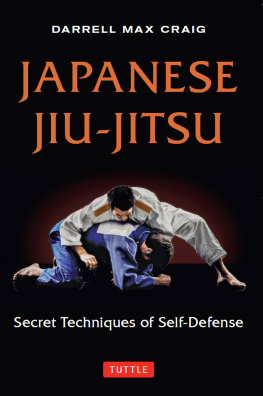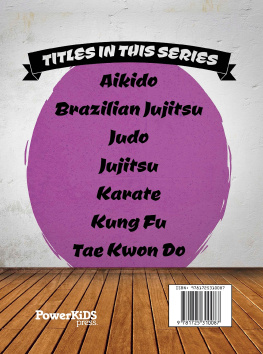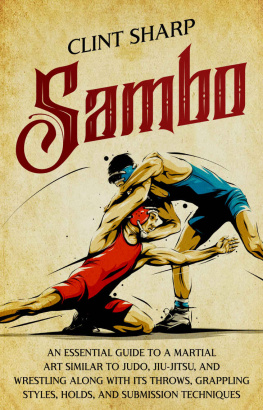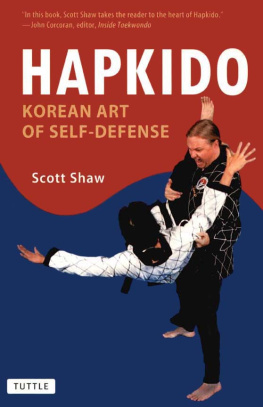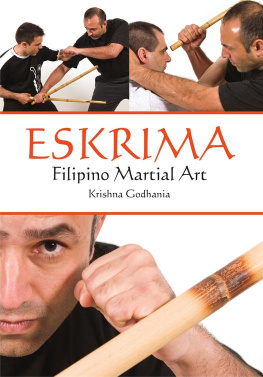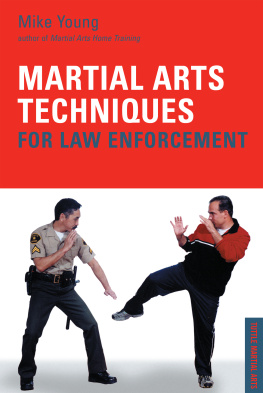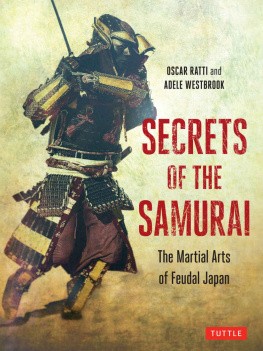Disclaimer
Please note that the publisher and author(s) of this instructional book are NOT RESPONSIBLE in any manner whatsoever for any injury that may result from practicing the techniques and/or following the instructions given within. Martial arts training can be dangerousboth to you and to othersif not practiced safely. If you are in doubt as to how to proceed or whether your practice is safe, consult with a trained martial arts teacher before beginning. Since the physical activities described herein may be too strenuous in nature for some readers, it is essential that a physician be consulted prior to training.
First published in 1995 by Tuttle Publishing, an imprint of Periplus Editions (HK) Ltd., with editorial offices at 364 Innovation Drive, North Clarendon, VT 05759 U.S.A.
Copyright 1995 by Darrell Craig.
All rights reserved. No part of this publication may be reproduced in any form or by any means, electronic or mechanical, including photocopying, recording, or by any information storage and retrieval system, without prior written permission from Tuttle Publishing.
Library of Congress Cataloging-in-Publication Data
Craig Darrell.
Japan's ultimate martial art: jujitsu before 1882 / by Darrell
Max Craig.
167 p., 1161 p. of plates: ill.; 26 cm.
ISBN 978-1-4629-0279-8
I. Jiu-jitsuJapanHistory. 1. Title.
GVIII4.C73 1995
796.8' 15' 0952dc20 95008843
CIP
Distributed by:
Japan
Tuttle Publishing
Yaekari Building, 3rd Floor
5-4-12 Osaki, Shinagawa-ku Tokyo 141-0032
Tel:(03) 5437 0171; Fax: (03) 5437 0755
Email: tuttle-sales@gol.com
North America, Latin America & Europe
Tuttle Publishing
Airport Industrial Park
364 Innovation Drive
North Clarendon, VT 05759-9436
Tel: (802) 773 8930, Fax: (802) 773 6993
Email: mfo@tuttlepublishing.com
Asia Pacific
Berkeley Books Pte. Ltd.
61 Tai Seng Avenue, #02-12
Singapore 534167
Tel: (65) 6280 1330; Fax: (65) 6280 6290
Email: inquiries@periplus.com.sg
Website: www.periplus.com
All photographs (except where credit is given) are by the author.
08 07 06 05 04 10 9 8 7 6
Printed in Singapore
This book is dedicated to all those teachers who carry the flickering lantern of light so that others may follow, and to those students who stumble and fall along the path of budo, unable to proceed by themselves.
I would also like to dedicate this work to the one student whose constant nagging caused me to finish it and to Mrs. Mary Schulz.
PREFACE
I WAS ONCE asked why I wanted to subtitle this book Jujitsu Before 1882. At the time, I was unable to come up with an exact answer. All I knew was that the tide "felt" appropriate becauseas everyone knowsit was in 1882 that judo gained ascendancy and jujitsu began its decline. I now know the answer: today, judo is a sport, with highly detailed rules and regulations. Jujitsu, however, has never been a sport. It has never had any rules, any barred techniques, or any concept of fair play; its only point has been to maim or kill your opponent. It is true that martial arts work best when someone is attacking you; nevertheless, in many jujitsu techniques the technician becomes the aggressor and gives no quarter to his prey.
This book is about jujitsu in all its traditional deadly nature, and about how it was originally taught and applied. Beginning in 1882, some of the techniques demonstrated in this book ceased being taught as widely and frequently as they once were. They have, in a sense, become relics of past glories, anachronisms in today's world. Many of the wonderful old senseis who mastered these techniques and passed them on to future generations are no longer with us. So that their knowledge and teachings will not be lost forever, I am particularly proud to include them in this book.
I suspect that the reader's motivation to purchase this book is similar to that which has recently rekindled an interest in Japan in learning traditional jujitsu methods. Throughout the judo world there are many who realize that modern judo has failed. Many have come to see judo not as its founder, Dr. Jigaro Kano, saw his art in 1882 but as some type of wrestling contest. The true art of what is left of judo lies hidden within its traditional kata. Even that has changed from decade to decade. This book is not about judo per se but about its predecessor, known originally as yawara and today as jujitsu, or taiho jitsu.
It was not until about 1930 that judo actually became fully separated from jujitsu. Until then judo was still referred to as Kano Jiu Jitsu ("Jiudo"). As late as 1938 a book published by S. J. Jorgensen referred to Kano Jiu Jitsu as the official jujitsu of the Japanese government. By that time, traditional jujitsu had fallen considerably from the high public stature it previously enjoyed. It was still taught, but mostly by and to ruffians and gamblers: a more refined art, called aikijitsu, was now being taught to the upper class.
In some instances it is hard to distinguish between the two arts. The difference lies more in how a technique is taught than in the technique itself. Nevertheless, judo was designed from jujitsu, and aikido was refined through aikijitsu. My first real exposure occurred in 1973, when I was in Japan studying kendo with Sensei Setsuji Kobayashi of the Imperial Palace Police. Through our conversations, I found out that Sensei Ichiro Hata had studied jujitsu, or, as the Japanese now called it, taiho jitsu. Sensei Hata was a government official with a deep and varied experience in Japanese martial arts.
I must admit that the names confused me at first. My first thoughts were that they were two different martial arts. As time passed and I was taken from police gym to police gym to study or observe, I realized that judo or kendo was taught to every policeman, while taiho jitsu was taught only to an elite officer group analogous to what we would call a SWAT (Special Weapons and Tactics) team, men in their middle or late twenties. Their workouts were Monday through Saturday for one hour, and they were the most excruciating I have ever witnessed. I was so impressed by what I saw that, when I returned to the United States, I wrote Sensei Hata a letter inviting him to come to Houston.
About one year later, Sensei Hata arrived for a three-week stay, and I began my study of jujitsu. Since that introduction, I have gone to Japan several times to study with Sensei Hata, and he has returned here several times. The experience has, for me, been invaluable.
The techniques demonstrated in the following chapters are of the Kaisho Goshin Budo Taiho Jitsu Ryu (KaishoTokyo Police; Goshinself-defense; Budomartial way; Taiho Jitsubody techniques). I have deliberately used Japanese terms throughout this book. This may, at times, be frustrating to the reader, but as the international art of ballet uses French terminology, the international art of jujitsu currently relies upon Japanese. To assist the reader, however, I have supplied a glossary of commonly used Japanese terms.
Similarly, because this book concerns itself with classical methods of jujitsu, the illustrations depict classical Japanese attire. Thus, the attacker (uke) is always depicted wearing the traditional loincloth ( the heko), and the defender (tori) is always shown wearing the traditional uniform top (uwagi) and divided pantlike skirt ( hakama ). I hope these drawings will get the readers in the mood of the times and increase enjoyment of this book. Rest assured: even though the attire may look a little strange, the techniques demonstrated work just as well on today's mean streets as they did centuries ago in the Japanese countryside.


